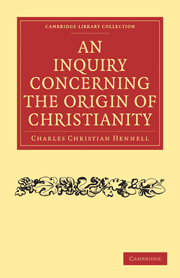Book contents
- Frontmatter
- PREFACE
- Contents
- ERRATA
- CHAPTER I Historical sketch, from the Babylonish captivity to the death of Jesus
- CHAPTER II Historical sketch, continued to the end of the first century
- CHAPTER III On the date and credibility of the Gospel of Matthew
- CHAPTER IV On the date and credibility of the Gospel of Mark
- CHAPTER V On the date and credibility of the Gospel of Luke
- CHAPTER VI On the date and credibility of the Gospel of John
- CHAPTER VII Examination of the accounts of the Resurrection and Ascension
- CHAPTER VIII Remarks on the other miracles in the four Gospels
- CHAPTER IX General objections to the miracles of Jesus
- CHAPTER X Remarks on the miracles in the Acts of the Apostles
- CHAPTER XI On the evidence afforded to the miracles by the apostolic writings
- CHAPTER XII On the prophecies
- CHAPTER XIII On the parts of Isaiah supposed to relate to Christ
- CHAPTER XIV On the book of Daniel
- CHAPTER XV Whether Jesus foretold his own death and resurrection
- CHAPTER XVI On the character, views, and doctrine of Jesus
- CHAPTER XVII Comparison of the precepts of Jesus with the Jewish writings
- CHAPTER XVIII Concluding reflections
- APPENDIX
CHAPTER V - On the date and credibility of the Gospel of Luke
Published online by Cambridge University Press: 05 March 2012
- Frontmatter
- PREFACE
- Contents
- ERRATA
- CHAPTER I Historical sketch, from the Babylonish captivity to the death of Jesus
- CHAPTER II Historical sketch, continued to the end of the first century
- CHAPTER III On the date and credibility of the Gospel of Matthew
- CHAPTER IV On the date and credibility of the Gospel of Mark
- CHAPTER V On the date and credibility of the Gospel of Luke
- CHAPTER VI On the date and credibility of the Gospel of John
- CHAPTER VII Examination of the accounts of the Resurrection and Ascension
- CHAPTER VIII Remarks on the other miracles in the four Gospels
- CHAPTER IX General objections to the miracles of Jesus
- CHAPTER X Remarks on the miracles in the Acts of the Apostles
- CHAPTER XI On the evidence afforded to the miracles by the apostolic writings
- CHAPTER XII On the prophecies
- CHAPTER XIII On the parts of Isaiah supposed to relate to Christ
- CHAPTER XIV On the book of Daniel
- CHAPTER XV Whether Jesus foretold his own death and resurrection
- CHAPTER XVI On the character, views, and doctrine of Jesus
- CHAPTER XVII Comparison of the precepts of Jesus with the Jewish writings
- CHAPTER XVIII Concluding reflections
- APPENDIX
Summary
The prefaces to this Gospel and the Acts shew that both proceed from the same author, and the earliest traditions agree that he was Luke, the companion of Paul, mentioned Col. iv. 14; 2 Tim. iv. 11; Philem. 24. There is some reason for supposing that he was the same as Silas.
This Gospel, like the others, is not alluded to in any of the speeches in the Acts, nor in the Epistles.
A.D. 96. Clement of Rome has a passage agreeing exactly with Luke xvii. 2 ; but nearly the same sentence is in Mark.
A.D. 140. Justin Martyr mentions the visit of Gabriel to the Virgin Mary, in the words of Luke i. 35—38; and Christ's agony, in the words of Luke xxii. 42; both which texts have no parallel one in the other Gospels. He does not mention Luke by name, but frequently speaks of the Gospels or memoirs composed by the Apostles and their companions, as his authority.
A.D. 178. Irenæus is the first who names Luke as the author of a Gospel. After speaking of Mark, he says, “And Luke, the companion of Paul, put down in a book the Gospel preached by him.”—“But the Gospel according to Luke being of a priestly character, begins with Zacharias the priest, offering incense to God.”—But if any one rejects Luke, as if he did not know the truth, he will be convicted of throwing away the Gospel, of which he professeth to be a disciple. For there are many, and those very necessary parts of the Gospel, which we know by his means.”
- Type
- Chapter
- Information
- An Inquiry Concerning the Origin of Christianity , pp. 93 - 103Publisher: Cambridge University PressPrint publication year: 2010First published in: 1838



